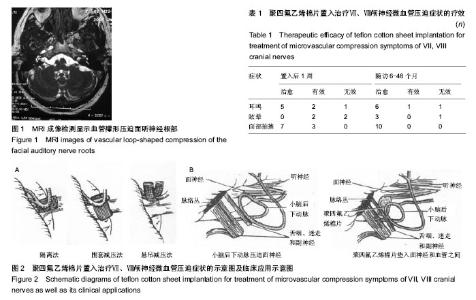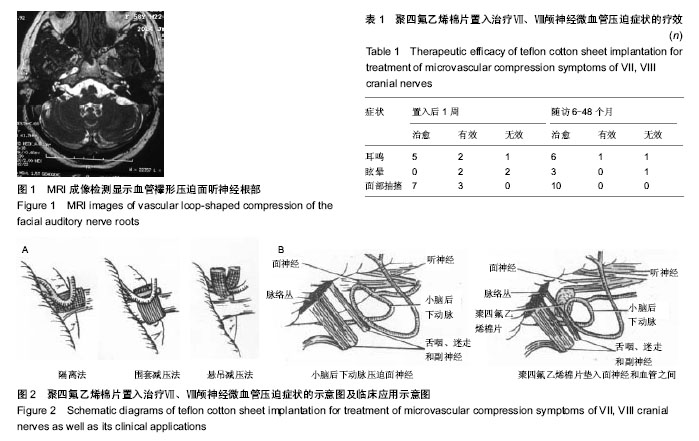Chinese Journal of Tissue Engineering Research ›› 2015, Vol. 19 ›› Issue (8): 1261-1266.doi: 10.3969/j.issn.2095-4344.2015.08.021
Previous Articles Next Articles
Teflon cotton sheet implantation for treatment of microvascular compression symptoms of VII, VIII cranial nerves
Feng Zhao-hai, Shi Xin, Jiang Lei, Hao Yu-jun
- Department of Neurosurgery, the First Affiliated Hospital of Xinjiang Medical University, Urumqi 830054, Xinjiang Uygur Autonomous Region, China
-
Revised:2015-01-14Online:2015-02-19Published:2015-02-19 -
Contact:Hao Yu-jun, Chief physician, Professor, Department of Neurosurgery, the First Affiliated Hospital of Xinjiang Medical University, Urumqi 830054, Xinjiang Uygur Autonomous Region, China -
About author:Feng Zhao-hai, Master, Physician, Department of Neurosurgery, the First Affiliated Hospital of Xinjiang Medical University, Urumqi 830054, Xinjiang Uygur Autonomous Region, China -
Supported by:the Natural Science Foundation of Xinjiang Uygur Autonomous Region, No. 2011211A064
CLC Number:
Cite this article
Feng Zhao-hai, Shi Xin, Jiang Lei, Hao Yu-jun. Teflon cotton sheet implantation for treatment of microvascular compression symptoms of VII, VIII cranial nerves [J]. Chinese Journal of Tissue Engineering Research, 2015, 19(8): 1261-1266.
share this article

2.1 参与者数量分析 10例患者均进入结果分析。 2.2 术中可见解剖学变化 7例为小脑前下动脉压迫第Ⅶ、Ⅷ颅神经,2例为椎动脉合并小脑前下动脉压迫第Ⅶ、Ⅷ颅神经,1例为小脑前下动脉压迫在Ⅷ根部合并一小动脉在Ⅶ、Ⅷ之间穿行压迫Ⅶ。8例为动脉压迫颅神经神经根出脑干区,1例动脉压迫颅神经Ⅶ、Ⅷ中段,1例动脉压迫颅神经Ⅶ、Ⅷ远端近内听道口处。 2.3 聚四氟乙烯棉片置入后的生物相容性及不良反应 10例均未出现排斥反应,验证了聚四氟乙烯棉片具有良好的生物学特性和组织相容性,置入颅内不会导致严重排异反应,不诱发组织粘连和肉芽肿形成,不会随时间的推移而吸收变形。 采用圈套式垫入聚四氟乙烯棉片的患者有2例术后发生感染,1例通过支持对症治疗,加强营养支持和提高患者免疫力,行腰椎穿刺脑脊液生化+常规检查,抗感染使用三代头孢类抗生素,隔日行腰椎穿刺释放异常脑脊液,病愈;1例行腰大池持续引流,结合静点万古霉素,4 d后病愈。而采用絮状式将聚四氟乙烯棉片撕成絮状,厚厚的铺在神经及压迫血管之间,并尽量避开之前神经被压迫部位,术后并未出现感染患者。 2.4 面部抽搐、眩晕及耳鸣改善情况 10例面部抽搐患者中,棉片置入后7例面抽症状完全消失,3例面抽症状减轻,置入后1周所有患者面抽症状均消失。棉片置入后1周,8例伴有耳鸣症状患者中,5例自觉耳鸣消失,2例自觉耳鸣减轻2级,1例耳鸣症状无改善;置入后随访6-48个月,6例耳鸣症状消失,1例减轻,1例无改善。4例合并眩晕患者中,棉片置入后即刻眩晕症状减轻2例,2例症状眩晕无改善;置入后1周,3例眩晕症状消失,1例眩晕症状减轻(表1)。 2.5 听觉功能测试结果 10例患者治疗前后均进行了纯音测听,用配对样本的t检验分析,显示治疗前后纯音平均听阈比较差异无显著性意义(t=0.009 8,P > 0.05)。 在脑干听觉诱发电位检测中,其中3例患者治疗后 Ⅰ-Ⅴ波潜伏期较治疗前缩短:治疗前Ⅴ波阈值分别为30,45,35 dB,治疗1个月后分别为30,45,40 dB;治疗前Ⅰ-Ⅴ波潜伏期分别5.2,5.5,5.7 ms,治疗1个月后分别为4.5,5.0,5.1 ms。 2.6 术后并发症 1例患者听力丧失(此患者治疗前面抽合并眩晕、耳鸣,听力差),1例患者术后听力下降;所有患者面神经功能均正常,未出现迟缓性面瘫等其他手术相关并发症。 2.7 随访情况 随访6-48个月,10例面部抽搐患者均无复发;5例耳鸣消失患者无复发,1例术后自觉耳鸣减轻患者6个月后耳鸣消失,1例术后自觉耳鸣减轻患者症状进一步改善,1例术后自觉耳鸣减轻患者症状无变化;2例术后眩晕减轻患者术后3个月至半年眩晕症状消失,1例眩晕无改善患者症状6个月后消失,1例眩晕症状无改善(表1)。"

| [1] De Ridder D,Heijneman K,Haarman B.Tinnitus in vascular conflict of the eighth cranial nerve:a surgical pathophysiological approach to ABR changes. Prog Brain Res.2007;166:401-411. [2] 徐兆水,赵可,唐林卡,等.桥小脑角病变显微手术828例病因分析[J].临床军医杂志,2007,35(1):47-49. [3] Kawashima M,Yamada M,Sato S,et al. Hemifacial spasm caused by vascular compression of the distal portion of the facial nerve assocciated with configuration variation of the facial and vestibulocoehlear nerve complex.Turk Neurosurg. 2009;19:269-275. [4] 刘蓬.耳鸣程度分级与疗效评定标准的探讨[J].中国中西医结合耳鼻咽喉科杂志,2004,12(4):181-183. [5] 吕海莲,罗树彬,许道洲,等.MR 3D FLASH—WE技术对特发性面肌痉挛显微血管减压的术前诊断价值[J].中国微侵袭神经外科杂志,2012,17(5):201-203. [6] Chung SS,Chang JH,Choi JY,et al.Microvascular decompression for hemifacial spasm:a long-time follow-up of 1169 consecutive cases.Stereotact Funct Nuerosurg.2001;面性77:190-193. [7] 中国医师协会神经外科医师分会功能神经外科专家委员会,北京中华医学会神经外科学分会,中国显微血管减压术治疗脑神经疾患协作组.中国显微血管减压术治疗面肌痉挛专家共识(2014)[J].中华神经外科杂志,2014,30(9):949-952. [8] 张凯,葛明,孟凡刚,等.显微血管减压术治疗面肌痉挛(附82例分析) [J].中国微侵袭神经外科杂志,2007,12(9):387-389. [9] Jannetta PJ,MolIer MB,Moller AR,et al.Neurosurgical treatmemnt of vertigo by microvascular decompression of the eighth cranial nerve.Clin Neurosurg.1986;33(2):645-665. [10] Moller MB,Moller AR,Jannetta PJ,et al.Diagnosis and Surgical treatment of disabling positional.J Neurosurg.1986;64(1): 21-28. [11] 陈颖东,徐达传,罗冬冬,等.神经内镜辅助锁孔入路下Ⅴ、Ⅶ、Ⅷ、Ⅸ脑神经与微血管显微解剖学研究[J].中国临床解剖学杂志, 2007,25(2):118-121. [12] Rhoton AL jr.The cerebellar arteries.Neurosugery.2000; 47(3Suppl):829-868. [13] Okamura T,Kurokawa Y,Ikeda N,et al.Microvasular Decompression for cochlear symptoms.J Neurosurg. 2000; 93(3):421-426. [14] Fukunaga A,Shimizu K,Yazaki T,et al.A recommendation on the basis of long-term follow-up results of our microvaseular decompression operation for hemifaeial spasm.Acta Neurochir (Wien).2013;155:1693-1697. [15] Samii M,Gunther T,Iaconetta G,et al.Microvascular decompression to treat hemifacial spasm:long-time results for a consecutive series of 143 patients.Neurosurgory. 2002;50: 712-719. [16] Guevara N,Deveze A,Buza V,et al.Microvascular decompression of cochlear ne rve for tinnitus incapacity: pre-surgical data, surgical analyses and long-term follow-up of 15 patients. Eur Arch Otorhinolaryngol.2008; 265(4): 397-401. [17] Ryu H,Uemura K,Yokoyama T,et al.Indications and results of neurovascular depression of the eight cranial nerve for vertigo tinnitus and hearing disturbances.Adv Otorhinolaryagol. 1998; 42(1):280-283. [18] 张卫峰,赵卫国,蔡瑜,等.脑神经微血管减压术治疗面肌痉挛合并耳鸣一例[J].中华显微外科杂志,2011,34(3):214. [19] Hyun SJ,Kong DS,Park K.Microvascular decompression for treating hemifacial spasm: lessons learned from a prospective study of 1,174 operations.Neurosurg Rev. 2010;33(3): 325-234. [20] 任杰,袁越,张黎,等.面肌痉挛微血管减压术中电生理监测对手术疗效的影响[J].立体定向和功能性神经外科杂志,2011,24(2): 65-68. [21] 石鑫,姜梅,买买提江,等.第Ⅷ脑神经显微血管减压术治疗耳鸣六例报告及文献复习[J].中华神经外科杂志,2010,26(3):209-211. [22] Sekiya T,Møller AR.Avulsion rupture of the internal auditory artery during operations in the cerebellopontine angle: a study in monkeys.Neurosurgory.1987;37(4):631-637. [23] 万亮,华续明,仲骏,等.显微血管减压术治疗原发性三叉神经痛的临床分析(附110例报告)[J].中华神经外科杂志,2009,25(3): 252-254. [24] 李世亭,潘庆刚,刘宁涛,等.微血管减压术治疗三叉神经痛的预后影响因素研究[J].中国神经精神疾病杂志,2004,30(3):169-172. [25] 庞明志,鲁晓杰,王鹏,等.神经内镜辅助锁孔入路微血管减压术治疗面肌痉挛34例分析[J].中华显微外科杂志,2013,36(2): 185-187. [26] 左焕琮,陈国强,袁越,等.显微血管减压术治疗面肌痉挛20年回顾(附4260例报告)[J].中华神经外科杂志,2006,22(11):684-687. [27] 于炎冰.显微血管减压术治疗颅神经疾病的现状与发展[J].中华神经外科杂志,2007,23(10):721-723. [28] 张黎,于炎冰,郭京,等.Teflon材料在神经外科显微血管减压术中的应用[J].生物医学工程研究,2004,23(1):44-45. [29] ZhongJ,Li ST,Zhu J,et al.Is entirenerve root decom—pression necessaryfor hemifaeial spasm?Int J Surg.2011;9(3):254-257. [30] Masuoka J,Matsushima T,Kawashima M,et al.Stitched sling retraction technique for microvascular decompression: procedures and techniques based on an anatomical viewpoint. Neurosurg Rev.2011;34(3):373-379. [31] 王旭辉,李心远,李轶,等.微血管减压术治疗面肌痉挛的预后因素分析[J].中华神经外科疾病研究杂志,2011,10(2):121-125. [32] Yap L,Pmhula VB,Lesser T.Microvascular decompression of cochleovestibular nerve. Eur Arch Otorhinolaryngol.2008; 265(8):861-869. [33] Cohen-Gadol AA.Microvascular decompression surgery for trigeminal neuralgia and hemifacial spasm: naunces of the technique based on experiences with 100 patients and review of the literature.Clin Neurol Neurosurg.2011;113(10):844-853. [34] 黄坤,段云平,高宝山,等.微血管减压术治疗面肌痉挛并耳聋?耳鸣[J].中华神经医学杂志,2007,6(8):819-821. [35] Peeraully T,Hameed S,Cheong PT,et al.Complementary therapies in hemifacial spasm and comparison with othermovement disorders.Int J Clin Pract.2013;67(8): 801-806. [36] 张京华.微血管减压术和药物治疗三叉神经痛的对比分析[J].当代医学,2013, 19(3):89-90. [37] 梁庆华,史畅文,张佳栋,等.面肌痉挛显微血管减压术中后组脑神经间隙的应用分析[J].中华显微外科杂志,2012,35(3):241-243. [38] 任鸿翔,于炎冰,张黎,等.显微血管减压术治疗面肌痉挛后出现延迟治愈的相关因素分析[J].中国微侵袭神经外科杂志,2012, 17(4):154-156. |
| [1] | Chen Ziyang, Pu Rui, Deng Shuang, Yuan Lingyan. Regulatory effect of exosomes on exercise-mediated insulin resistance diseases [J]. Chinese Journal of Tissue Engineering Research, 2021, 25(25): 4089-4094. |
| [2] | Chen Yang, Huang Denggao, Gao Yuanhui, Wang Shunlan, Cao Hui, Zheng Linlin, He Haowei, Luo Siqin, Xiao Jingchuan, Zhang Yingai, Zhang Shufang. Low-intensity pulsed ultrasound promotes the proliferation and adhesion of human adipose-derived mesenchymal stem cells [J]. Chinese Journal of Tissue Engineering Research, 2021, 25(25): 3949-3955. |
| [3] | Yang Junhui, Luo Jinli, Yuan Xiaoping. Effects of human growth hormone on proliferation and osteogenic differentiation of human periodontal ligament stem cells [J]. Chinese Journal of Tissue Engineering Research, 2021, 25(25): 3956-3961. |
| [4] | Sun Jianwei, Yang Xinming, Zhang Ying. Effect of montelukast combined with bone marrow mesenchymal stem cell transplantation on spinal cord injury in rat models [J]. Chinese Journal of Tissue Engineering Research, 2021, 25(25): 3962-3969. |
| [5] | Gao Shan, Huang Dongjing, Hong Haiman, Jia Jingqiao, Meng Fei. Comparison on the curative effect of human placenta-derived mesenchymal stem cells and induced islet-like cells in gestational diabetes mellitus rats [J]. Chinese Journal of Tissue Engineering Research, 2021, 25(25): 3981-3987. |
| [6] | Hao Xiaona, Zhang Yingjie, Li Yuyun, Xu Tao. Bone marrow mesenchymal stem cells overexpressing prolyl oligopeptidase on the repair of liver fibrosis in rat models [J]. Chinese Journal of Tissue Engineering Research, 2021, 25(25): 3988-3993. |
| [7] | Liu Jianyou, Jia Zhongwei, Niu Jiawei, Cao Xinjie, Zhang Dong, Wei Jie. A new method for measuring the anteversion angle of the femoral neck by constructing the three-dimensional digital model of the femur [J]. Chinese Journal of Tissue Engineering Research, 2021, 25(24): 3779-3783. |
| [8] | Meng Lingjie, Qian Hui, Sheng Xiaolei, Lu Jianfeng, Huang Jianping, Qi Liangang, Liu Zongbao. Application of three-dimensional printing technology combined with bone cement in minimally invasive treatment of the collapsed Sanders III type of calcaneal fractures [J]. Chinese Journal of Tissue Engineering Research, 2021, 25(24): 3784-3789. |
| [9] | Qian Xuankun, Huang Hefei, Wu Chengcong, Liu Keting, Ou Hua, Zhang Jinpeng, Ren Jing, Wan Jianshan. Computer-assisted navigation combined with minimally invasive transforaminal lumbar interbody fusion for lumbar spondylolisthesis [J]. Chinese Journal of Tissue Engineering Research, 2021, 25(24): 3790-3795. |
| [10] | Hu Jing, Xiang Yang, Ye Chuan, Han Ziji. Three-dimensional printing assisted screw placement and freehand pedicle screw fixation in the treatment of thoracolumbar fractures: 1-year follow-up [J]. Chinese Journal of Tissue Engineering Research, 2021, 25(24): 3804-3809. |
| [11] | Shu Qihang, Liao Yijia, Xue Jingbo, Yan Yiguo, Wang Cheng. Three-dimensional finite element analysis of a new three-dimensional printed porous fusion cage for cervical vertebra [J]. Chinese Journal of Tissue Engineering Research, 2021, 25(24): 3810-3815. |
| [12] | Wang Yihan, Li Yang, Zhang Ling, Zhang Rui, Xu Ruida, Han Xiaofeng, Cheng Guangqi, Wang Weil. Application of three-dimensional visualization technology for digital orthopedics in the reduction and fixation of intertrochanteric fracture [J]. Chinese Journal of Tissue Engineering Research, 2021, 25(24): 3816-3820. |
| [13] | Sun Maji, Wang Qiuan, Zhang Xingchen, Guo Chong, Yuan Feng, Guo Kaijin. Development and biomechanical analysis of a new anterior cervical pedicle screw fixation system [J]. Chinese Journal of Tissue Engineering Research, 2021, 25(24): 3821-3825. |
| [14] | Lin Wang, Wang Yingying, Guo Weizhong, Yuan Cuihua, Xu Shenggui, Zhang Shenshen, Lin Chengshou. Adopting expanded lateral approach to enhance the mechanical stability and knee function for treating posterolateral column fracture of tibial plateau [J]. Chinese Journal of Tissue Engineering Research, 2021, 25(24): 3826-3827. |
| [15] | Zhu Yun, Chen Yu, Qiu Hao, Liu Dun, Jin Guorong, Chen Shimou, Weng Zheng. Finite element analysis for treatment of osteoporotic femoral fracture with far cortical locking screw [J]. Chinese Journal of Tissue Engineering Research, 2021, 25(24): 3832-3837. |
| Viewed | ||||||
|
Full text |
|
|||||
|
Abstract |
|
|||||